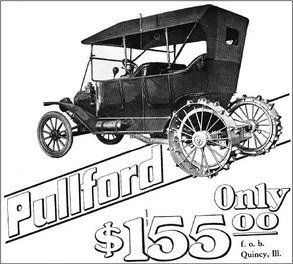Tractor maker was careful to hedge its bet

In the early 1900s, farming was going through an era of transition. The horse was being replaced by the mechanization of the tractor. Two Quincy companies were at the forefront of this. Electric Wheel made the Allwork, and Dayton-Dick made the Leader brand of tractor.
Each produced several models of its tractor in various ranges of horsepower.
In October 1916 a new Quincy company called the Pullford Co. started production of an attachment that would turn a Ford Model T into a tractor. The price of a full-size tractor was about $1,500, but a Model T cost less than $400. The Pullford attachment sold for $135, so a farmer could have both in one vehicle for just over $500. The Pullford Company advertised extensively in farm publications all over the country, and in 1917 it sought to take part in the National Tractor Demonstrations, which were held near Fremont, Neb. The companies that manufactured full-size tractors objected to including attachment makers in the demonstrations because they feared the competition.
Gasoline and kerosene tractors had just come into their stride as new inventions, being created a little more than a decade before, and attachment manufacturers were about to cut into their sales because the attachments sold for much less than a full-size tractor. A special demonstration that was not sanctioned by the organization responsible for the main event was held outside Fremont.
All the attachment manufacturers, including Pullford, exhibited their products at this show.
The farmers could see both the
traditional tractor and the converted Model T plow fields, and they could compare the results for themselves. About 300,000 farmers attended the demonstration, along with several farm magazine and newspaper reporters who were there to cover the exposition. This test showed that the small farmer could have the power necessary to replace or supplement the horse by making use of something he might have already on the farm. The price of the automobile had come down enough for the average farm family to buy one. Of the farm families that had bought a car, 75 percent purchased a Model T. Now for just a few dollars more, he could have a tractor, as well. With an attachment like the Pullford, the small farmer could plow his field on Saturday and take his family to church on
Sunday.
One of the problems discovered before the exposition was that the Model T’s radiator was too small for the strenuous work of the farm and would overheat when pressed. This problem was corrected when Addison Calkins of Electric Wheel Company submitted a patent for the “Auxiliary Engine-Cooling Means.” This device consisted of a heavy-duty fan and housing that directed the air current through the radiator more swiftly. The device was created just in time for Pullford to include it with the exhibition, making it a success. Pullford got the reputation as being the “poor man’s tractor.”
This invention by Calkins gives one an idea who really owned the Pullford Co. Electric Wheel Co., also a Quincy company,
made full-size tractors and
was a member in the same tractor manufacturers’ organization that objected to the participation by attachment manufacturers in the Fremont Tractor Demonstrations. By setting up a separate company called Pullford to manufacture and distribute the tractor attachment, Electric Wheel could sell both products, thus hedging its bet on the mechanization of the farm. The only other clue as to the ownership of the company was that the same image of the factory appeared on both Pullford and Electric Wheel product catalogs.
The Pullford consists of the wheels, frame and gears necessary to reduce the Ford’s energy to power instead of speed. The gears convert the speed to power by a reduction of 11 to one. This is done by replacing the Ford rear wheel with an eight-tooth pinion that meshed with an 88-tooth gear attached to the Ford drive wheel. This 88-to-eight reduction was a simple solution to the conversion of the Model T.
One of the biggest selling points was that it could be easily attached to the Ford in less than 40 minutes the first time the farmer converted the vehicle.
One man could do the job with a single tool, a monkey wrench.
He simply removed the rear wheels and fenders and replaced the wheels with the pinions. He then attached the Pullford frame to the rear axle by snapping the hook shaped clamp to the front of the Ford frame and attaching
the axle to the rear of the frame with two U-bolts. This task could be performed with no holes drilled in the Model T. It could be removed in 10 minutes and be quickly returned to pleasure use again.
Several other up-start firms entered the attachment business along with Pullford. Some of the largest competitors were Smith Form-a-tractor, which sold for $255; Staude Mak-a-Tractor, selling for $195; and Unitractor kits, which sold for $175. The Pullford at $135 had a price advantage over other manufacturers. The Model T was produced from 1908 until 1927, when the Model-A was introduced. Fifteen million Model-Ts were produced during that time, many of which remained in use for several decades. So Pullford had a large consistent supply of vehicles available to convert into a tractor.
When the Model-A was introduced and the Chevrolet became popular, Pullford introduced conversion kits to convert those vehicles to tractors. The Pullford remained in business until the early 1940s, when cars became more complicated than the simple Model T, and the average farm size grew too big for the use of a Pullford. The company then just seemed to fade away.
Dave Dulaney is a local historian and a member of several history-related organizations. He is a speaker, an author and a collector of memorabilia pertaining to local history and steamboats.






